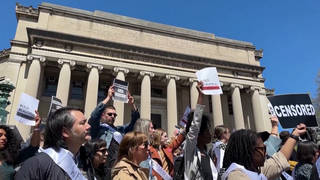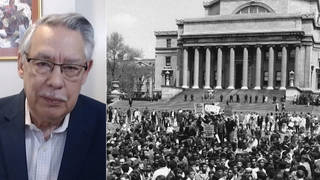
Topics
Guests
- John LipscombRiverkeeper boat captain and director of Riverkeeper’s Water Quality Program.
- Phillip Musegaasdirector of Riverkeeper’s Hudson River Program.
Many of the East Coast’s waste treatment plants failed during Superstorm Sandy, causing them to release thousands of gallons of raw sewage into the area’s waterways. This mixed with other pollutants, like more than 330,000 gallons of diesel fuel spilled near Arthur Kill, the waterway that separates New Jersey from Staten Island. In this video report, Democracy Now! teams up with the watchdog group Riverkeeper to tour New York City’s industrial waterfront four days after the storm. They find mixed results from water samples taken along the way. The piece is produced by Democracy Now!’s Renée Feltz and Sam Alcoff, and filmmaker Sara Kinney.
Click here to learn more about Riverkeeper.
JOHN LIPSCOMB: I’m John Lipscomb, and I run the patrol boat for Hudson Riverkeeper. I also do our water quality sampling from this boat. And we’ve come down today to see what New York Harbor looks like post-Sandy.
So here we are at the—a mouth of Newtown Creek. We’re on the East River, which of course isn’t a river. It’s a tidal straight between Long Island Sound and the upper bay of New York Harbor. United Nations is right here. And Newtown Creek runs back about three-and-a-half miles between Queens and Brooklyn.
So here we are four days after the storm and four days after those super tides, and we’re seeing, so far, very little floating trash in the harbor. But there had to be vast amounts of it. And we just don’t know where it’s gone. Well, here is an example of where some of it’s gone. This is just one little 150-foot piece of fence, and you can see that the fence acted like—almost like a fishnet. When the tide was high, it captured all this floating garbage. And then the tide went down, and it was hung up on this edge. So, somewhere in the harbor, there’s got to be lots and lots and lots of trash.
Now, this is interesting here. This lot, you’ll—you know, we’re going to see little clues today that tell us the story of what happened four days ago. Every one of these vehicles has its doors open and its hood open. My guess is that every one of these vehicles drowned, and now they’re drying them out, trying to keep them going. See, every one of them is open. I’m going to ask this guy.
So, did all these vehicles take a swim?
TIME WARNER WORKER: Yep, all of these, even the ones that are on the inside.
JOHN LIPSCOMB: Good luck.
So he says that—he said they all flooded, even the ones that were in the building.
This scrap yard had to flood. So, you know, one of the—one of the things that we’re looking—you know, we’re looking for visible signs. But imagine all the metabolic fluids from all the metal that’s here. All that was rinsed off into the water. It’s now part of the grand total contamination. Imagine if you had, sitting on a commercial dock, 10 containers of some kind of a pesticide. They float off the dock. They’re sitting on the bottom. So they’re like a giant toxic Alka-Seltzer sitting on the bottom. That’s stuff we don’t see.
They’ve got a problem with the boom, Philip.
PHILLIP MUSEGAAS: They do?
JOHN LIPSCOMB: Yeah, and a container, one of the remediation containers, floated off the bulkhead.
PHILLIP MUSEGAAS: I’m Phillip Musegaas. I’m the Hudson River program director at Riverkeeper. This is the site of the ExxonMobil spill. And normally we have a boom that contains any oil seepage that runs along this entire shoreline. What we found is the boom has been torn loose and basically doubled back on itself, so we’re going to have to report that. And when we came further in, we saw there’s a shipping container that’s—actually, we just learned, was blown off a property across the creek and further in, all the way downstream, and has been hooked up on this property and basically just landed here. So we’re going to report this to the city. But here you can see the boom, where it’s—this boom should be running entirely along the shoreline, and it’s basically—this end has broken loose. This end should be all the way down on that end of the property.
We’ll report all this back to the state and the city and the Coast Guard, and hopefully get some response and get some cleanup. But we know from—the state environmental officials are completely overwhelmed at this point. They’ve basically told us they’re not even responding to what they call “surface spills.” So, even if we saw an oil spill here in the creek, we’d have to try and get the Coast Guard involved. The state environmental bureau is just not even able to take that on. And so, you know, when you have a storm like this and you have a state government that’s—that’s kind of lacking resources, under budget, you really see a—it really affects the environment, because they can’t respond the way they should to clean up these situations. So…
JOHN LIPSCOMB: OK, so what I’m going to do here is I’m just going to stop the boat and fill this bottle, and that’s it. Twenty-four hours from now, we’ll have a cell count on an indicator microbe that indicates sewage, untreated sewage.
Well, I’m putting on a glove, because this water here can be extremely contaminated, and I’d rather not get sick.
And that’s it. Anybody want a sip? Here, here. Here you go. Come on.
So we’ve came out of Newtown Creek. We ran down the East River, around Governor’s Island and into Gowanus Bay behind us. Now we’re entering the Gowanus Canal right ahead here. This, again, is one of these historic legacy polluted waterways of New York Harbor. We’ve had a number of cases here. It’s also a Superfund site, designated by the EPA. There’s going to be a big cleanup here. You know, we’re just interested in seeing if we can see any consequences of the storm here.
RENÉE FELTZ: So how much did Superstorm Sandy pollute the New York City Harbor? This is Democracy Now!’s Renée Feltz with an update from Riverkeeper.
While we were out on the water, Captain John Lipscomb collected six samples, on which he ran tests for enterococcus, an indicator of fecal contamination from raw sewage. Two of the locations exceeded the EPA’s limit of 104 cells per 100 milliliters. One was the inner end of Newtown Creek, where the cell count was 171. And near the entrance of the Gowanus Canal, the cell count reached 24,200, exceeding the Riverkeeper lab’s range of measurement. Water from both of these sites flooded the city streets during the storm.
JOHN LIPSCOMB: Whatever came off the shore that could be dissolved got in the water and becomes part of that background contamination that—that is New York Harbor. A lot of different—a lot of pollutants attach to sediment particles and then drop to the bottom. PCBs, for example, are one of the famous ones that do that. So if a load of PCBs came off, they didn’t just go in dissolution and go off into the Atlantic, where we can pretend they don’t exist anymore. They came off the shore. They’re heavy. They attach to particles, and they drop. So, you know, the contamination in New York Harbor is the result of decades and centuries, almost, of death by a thousand cuts. Well, this event was maybe like a machete cut. This was a big one. This contributed a lot of—a lot of contamination to New York Harbor. But it’s not like it was a pristine system before.










Media Options